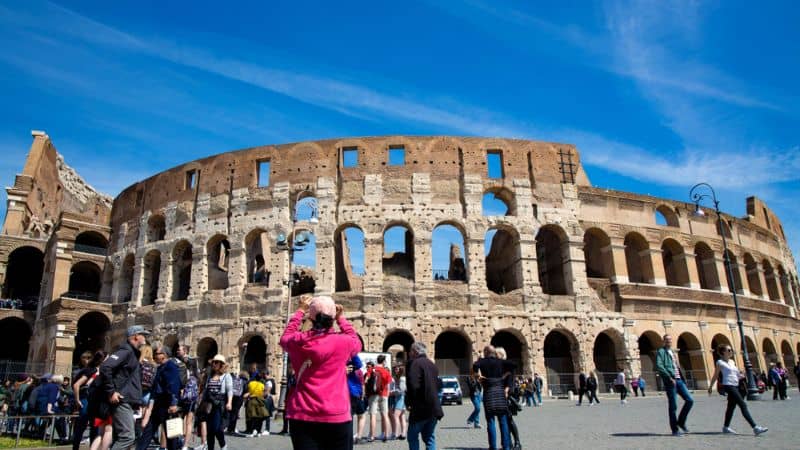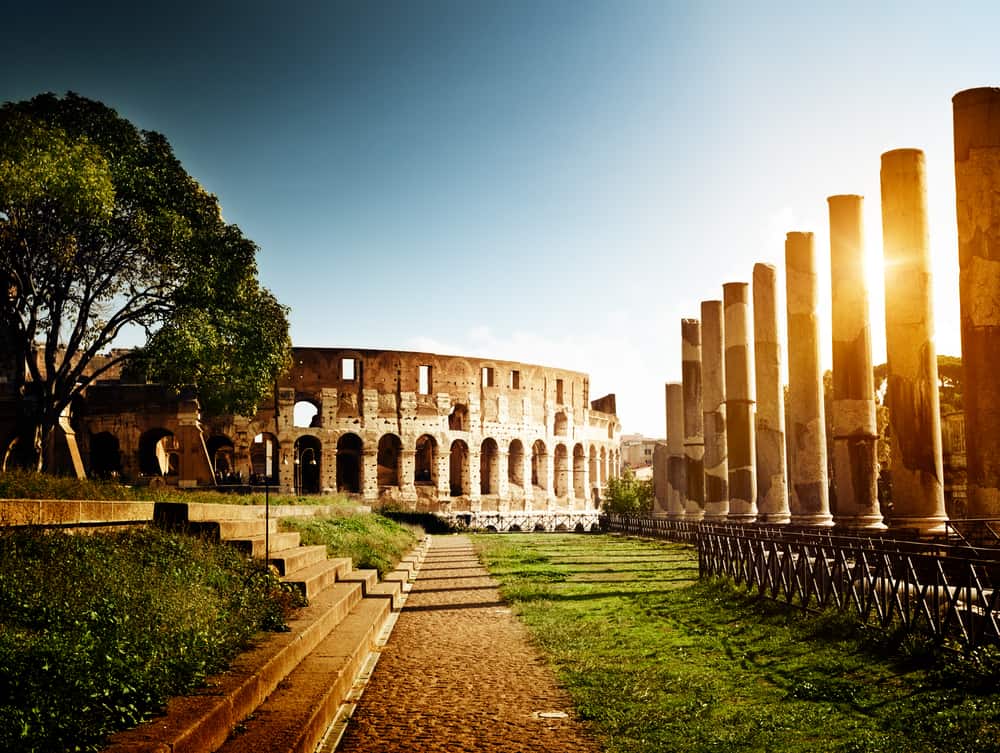When visiting Rome, a trip to the iconic Colosseum is an absolute must for any traveler’s itinerary. As one of the most recognizable tourist attractions in the world, the Colosseum sees over six million visitors each year, drawn by its rich history and architectural prowess. As the largest amphitheater ever built, it stands as a symbol of ancient Rome’s power and a testament to the engineering expertise of the Roman Empire.
Proper planning is essential to make the most of your visit to the Colosseum. It’s important to note that the lines to enter can be quite long, but with adequate preparation, you can save time and avoid these queues. Tickets for the Colosseum can be purchased online, and for 16€, provide access to the Roman Forum and Palatine Hill. The ticket is valid for 24 hours and allows one entry per attraction.
There are numerous options for accessing the Colosseum via public transport. The easiest way is to take the Metro B line and get off at the Colosseum metro stop. Other options include the Metro A line to Manzoni stop followed by the number 3 tram line or choosing from several nearby bus lines.
| Aspect | Details |
|---|---|
| What is it? | An iconic ancient amphitheater, the largest ever built in the Roman Empire. |
| Location | East of the Roman Forum, Rome, Italy. |
| Construction | Started in 72 AD under the Flavian Dynasty, completed in 80 AD. |
| Architecture | Elliptical shape, built with stone and concrete, with a central arena. |
| Capacity | Could hold up to 50,000 to 80,000 spectators. |
| Events | Hosted gladiatorial contests, animal hunts, executions, and other public spectacles. |
| Must-See Features | Hypogeum (underground tunnels), Velarium (retractable awning system), outer façade with arched entrances. |
| Ticketing | Advance booking recommended for skip-the-line access and guided tours. |
| Nearby Attractions | Roman Forum, Palatine Hill, Arch of Constantine. |
History and Significance

Roman History
The Roman Colosseum, the Flavian Amphitheater, symbolizes ancient Rome’s architectural and engineering prowess. Located just east of the Roman Forum, the massive arena held thousands of spectators to witness various events, including gladiator battles and animal hunts and is now one of the most famous landmarks in Rome and Europe.
Construction of the Colosseum began sometime between 70 and 72 CE under Emperor Vespasian and was completed in 80 CE by his son, Titus. The Colosseum was built on the grounds of Nero’s Domus Aurea, a sprawling palace complex that symbolized the excesses of his reign. By constructing the amphitheater, Vespasian reclaimed the land for public use and gave the gift of entertainment to the Roman people.
Emperors
Several Roman emperors played significant roles in the history of the Colosseum. Vespasian initiated its construction, and his son Titus inaugurated it with a series of games and celebrations that lasted 100 days.
Emperor Domitian, Vespasian’s youngest son, made further additions to the Colosseum, including a hypogeum—a network of tunnels beneath the arena floor where gladiators, animals, and stage equipment were kept. This underground system allowed for elaborate and efficient staging of battles and events.
Gladiators
The Colosseum’s primary purpose was to host gladiatorial contests and spectacles. Gladiators were typically slaves or prisoners of war, trained to fight to the death, although occasionally, free men would participate to gain wealth and fame. Battles took place in the arena, often using a variety of weapons and armor styles.
Alongside gladiatorial combat, the Colosseum featured other entertainments such as animal hunts, called venationes. These events involved exotic animals such as lions, elephants, and tigers, imported from far-flung corners of the empire. Skilled hunters, or venatores, fought or killed the beasts for the crowd’s enjoyment.
The reign of Constantine the Great brought changes to the Colosseum’s programming. He was a Christian emperor, and gladiatorial combat began to decline in popularity under his rule, eventually ending.
Today, the Colosseum is an iconic landmark and a major source of tourism revenue for the Italian government. It stands near the Arch of Constantine, a triumphal arch built to commemorate Constantine’s victory over his rival, Maxentius. Visitors can explore the historic amphitheater and imagine the grand spectacles that once took place within its walls.
Visiting the Colosseum

Best Times to Visit
The Colosseum is a popular tourist attraction in Rome, welcoming over six million visitors annually. To ensure a worthwhile experience, it’s best to visit during the morning hours from Thursday to Sunday, as these mornings tend to be less crowded.
If you prefer a unique experience, consider visiting the Colosseum at night for a special guided tour. Be aware that the opening times may vary depending on the season, so it’s best to check the official website for accurate information.
Season-wise, it is advised to avoid visiting during the peak summer due to the scorching heat and larger crowds. Spring and autumn offer a more pleasant experience, with mild temperatures and fewer tourists.
Planning Your Trip
Visiting the Colosseum efficiently requires understanding ticket options and planning for nearby attractions. The Colosseum is located at Piazza del Colosseo, and its GPS coordinates are 41.8902° N, 12.4922° E. The easiest way to reach it is via public transportation, such as Linea B metro line, getting off at the ‘Colosseo’ station.
See Related: Best Things to Do in Rome, Italy
Tickets and Tour Options
Basic tickets for the Colosseum cost 16€ (18€ with online booking) and grant access to the Roman Forum and Palatine Hill. They’re valid for 24 hours and allow one entry to each attraction. EU citizens aged 18-25 can purchase tickets for 2€. To ensure a smoother visit, consider options such as skip-the-line tickets, tourist cards like the Roma Pass, or guided tours that cover the attractions efficiently.
- Colosseum Ticket Options:
- Basic Tickets
- Priority Entrance
- Skip-the-Line Access
- Roma Pass
For those interested in visiting specific sections, such as the underground (Hypogeum), the arena floor, or the second floor, special guided tours offer exclusive access to these areas. Ensure to dress comfortably and modestly, adhering to the dress code.
To enhance your Colosseum experience, consider combining your visit with other popular attractions in Rome, such as the Vatican Museums or the Sistine Chapel.
Tips for Visiting the Colosseum
Visiting this iconic amphitheater is a memorable experience, and following these tips can help you make the most of it:
- Arrive early to avoid long queues
- Utilize skip-the-line options or guided tours
- Check the opening times in advance
- Dress comfortably and follow the dress code
- Consider visiting multiple attractions with a tourist card
Tickets might sell out during peak seasons, so booking is recommended. Also, note that backpacks, luggage, and other large items are generally prohibited inside the Colosseum.
Nearby Attractions and Accommodations

There are numerous eateries and accommodations available near the Colosseum. ‘Visitors with disabilities will find the site wheelchair-accessible, with a separate entrance for easy access.
Where to Eat
- Ristorante Pancrazio
- Ristorante Colosseo
- Ristoro Della Salute
Where to Stay
Nearby Attractions
Roman Forum
The Roman Forum is an essential site to visit near the Colosseum. It was once the center of ancient Rome, housing many important buildings and structures. Today, visitors can stroll through the ruins and imagine life during the Roman Empire. Some highlights of the Roman Forum include the Arch of Septimius Severus, the Temple of Saturn, and the Curia Julia.
Palatine Hill
Palatine Hill is another must-see attraction close to the Colosseum. As one of the oldest and most significant sites in Rome, it offers visitors a chance to explore the ruins of ancient palaces and gardens. The extensive archeological complex allows one to find peace away from the crowds while admiring the breathtaking views of Rome. To make the most of your visit to Palatine Hill, set aside a few hours to wander through its historic paths and enjoy the rich heritage of this remarkable area.
Vatican Museums
Although not directly adjacent to the Colosseum, the Vatican Museums are a major attraction for anyone visiting Rome. A quick trip across the city will take you to this vast complex of galleries and museums, which house some of the world’s most significant art collections.
Visitors can marvel at the works of Michelangelo, Botticelli, and other renowned artists as they explore the Vatican Museums. A highlight of a visit is the Sistine Chapel, famous for its magnificent ceiling frescoes painted by Michelangelo. Plan your visit, as the Vatican Museums and Sistine Chapel are highly popular among tourists and may require booking or timed entry tickets.
See Related: Best Time to Visit Venice, Italy
Colosseum Events and Experiences

Gladiator Fights
The Colosseum’s most famous events were the epic gladiator fights, where brave warriors fought to the death in brutal combat. These gladiators came from various backgrounds, including slaves and prisoners of war, as well as volunteers looking for glory and fortune. The battles were meticulously choreographed and the weapons, armor, and fighting styles varied to create a thrilling spectacle for the audience.
Gladiator fights often had the following characteristics:
- Weapons, including swords, daggers, spears, and nets
- Armor specific to different gladiator types, such as the murmillones wearing heavy helmets and carrying large shields
- A variety of combat scenarios, such as one-on-one duels, group battles, and reenactments of historical events
Animal Hunts
Animal hunts, known as venation, were another popular event in the Colosseum. Trained hunters, known as venatores or bestiarii, faced off against exotic wild animals captured from the Roman Empire’s far reaches. These events showcased the might and skill of the hunters, as well as the variety of Rome’s imperial conquests.
Some features of the animal hunts included:
- A wide range of animals, such as lions, tigers, elephants, and rhinoceroses
- The use of traps, pits, and other elements makes the hunts more challenging and exciting
- The display of these animals for public viewing before the actual hunts commenced
Both gladiator fights and animal hunts entertained the Roman public and demonstrated the Empire’s power and wealth. Although these events occurred nearly 2,000 years ago, they continue to captivate the imagination and offer a glimpse into the Colosseum’s and ancient Rome’s extraordinary history.
Related Resources:


0 Comment